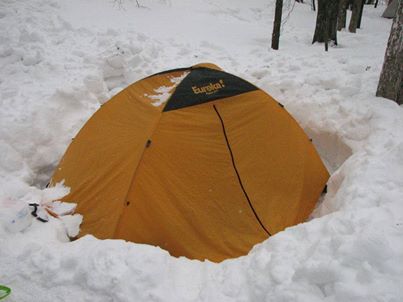It’s cold out today. . . was cold out yesterday. For some hardcore adventurers, it isn’t a bother. In fact, the joy of having NO bugs, No one on the trail, no noise, no trash and excellent unobstructed views makes for great adventures. Winter is a perfect time to get out into the wilderness and explore. You just have to gain a little knowledge to stay comfortable and warm. It isn’t really that hard.
Humans output the heat of an incandescent light bulb, from 70 watts to 870 watts, depending on the amount of physical activity undertaken. There are four avenues of heat loss: convection, conduction, radiation, and evaporation. If we can manage to balance these two concepts (and avoid sweating), we can be quite comfortable in Arctic Conditions. Here are a few thoughts to get you started.
Feed the Furnace
Bring food that won’t freeze and keep it inside your insulating layer near your body. Snacks like chocolate, cookies, nuts, gorp, cheese pieces and summer sausage are good to keep your furnace fueled. Add butter to meals during long trips. You use more calories in cold weather and could use the fat to keep warm. Snacks and drinks should be a cold weather habit. It is important to stop and fuel up. Consider following a schedule. Such as – ski for 45 minutes to an hour and then take a few minute break to cool off, eat and drink.

Bring the Right Stove
Liquid fuel works in the cold, but canister stoves have fuels that turn to liquid and won’t vaporize and burn. Use a plastic fuel bottle or duct tape wrapped around a metal bottle to prevent frostbite to the fingers and hands. Liquid fuel makes metal bottles dangerous. They could cause injury to the skin.

Don’t Let Your Water Freeze
Put your bottles in insulation. Insulated carriers or even wool socks work good. Occasionally, bring the bottle inside your insulating layer if possible. Use wide-mouthed bottles. Wide mouth bottles take longer to freeze. Also, water tends to freeze at the top of the bottle first. Flipping them upside down means the bottom of the bottle will freeze first.
Modify Your Zipper Pulls
Most outdoor gear has zippers. Most zippers aren’t designed to be pulled with mittens (or insulated gloves). You can add longer pulls about 3 – 4 inches. Take about 7 inches of lanyard, tie it into a loop, then use a girth hitch to attach it to a zipper. By doing this, you eliminate the need to take your gloves off each time you need to unzip something.

Protect Your Power Sources
Pack lithium batteries. Lithium is less affected by the cold. Alkaline batteries react poorly in subfreezing temperatures. Place rechargeable devices inside your insulating layer, in a pocket, to keep them warm. Low/Cold batteries will gain power if warmed up.
Don’t Sweat
You may have the best wicking base layer available, but it doesn’t matter if you sweat too much. Sweat is a problem in extreme cold. Stopping for just a few minutes will increase your risk of hypothermia. Don’t be afraid to make adjustments often. Even in extreme cold, you may have to unzip your jacket or take your hat off to keep from sweating. Despite your best efforts (and without even knowing it) you may sweat. It is important – when stopping – to replace wet clothing with dry.
Keep Your Feet Warm and Dry
Keep the inside of your boots dry. If you have liners, take them out and sleep with them in your bag (keep your socks in your bag as well). You can also take out the insoles. Take the liners/insoles and put them in a stuff sack. Then put them in your sleeping bag warmer feet in the morning.
Vapor Barriers for Your Feet
Non-breathable “socks” are warm and will keep sweat from soaking your socks and boots. The commercial silicone-impregnated vapor barriers can be expensive, but plastic grocery or bread bags will work, too. You can also use oven bags between your feet and socks; the non-breathable layer keeps moisture from getting your socks and boot liners wet.
Avoid Campsites in Low Areas
Cold air settles in low areas. You don’t want to camp on a hilltop because the wind is more severe in an exposed location, but choose a campsite that is elevated from its immediate surroundings.

Use Activity and External Heat
Get your furnace working before you crawl into your bag. Go for a brisk walk, do some exercise to produce body heat. When you are just about to the point of sweating, then get yourself to your sleeping bag. You can also put hot water bottles or heat packs at your main arteries – armpits, crotch, neck, middle of your chest. Make sure you have good insulation under you. Closed cell foam pads work best for conduction. Air mattresses are less effective. Consider a reflective blanket as part of your barrier too.
You can also burn candles. The candle will provide a little light, but you can also use it for warmth. A candle lantern (and candles) can raise the temperature in a tent or vehicle a few degrees. Don’t keep an open flame in your shelter, use a candle lantern to prevent any trouble.
Use a Small Amount of Water to Make Water
If you are melting snow in a pot with a stove, put a small amount of water at the bottom, then add the snow. Warming the water puts heat in contact with more surface area of the snow, thus increasing your melting potential. Without a small amount of water, the snow in contact with the pot will turn icy and maybe even burn the bottom of the pot.
While there are many other tips, tricks and techniques to keep you warm in arctic conditions, these few tips will go a long way to helping keep you comfortable in the blowing snow.
